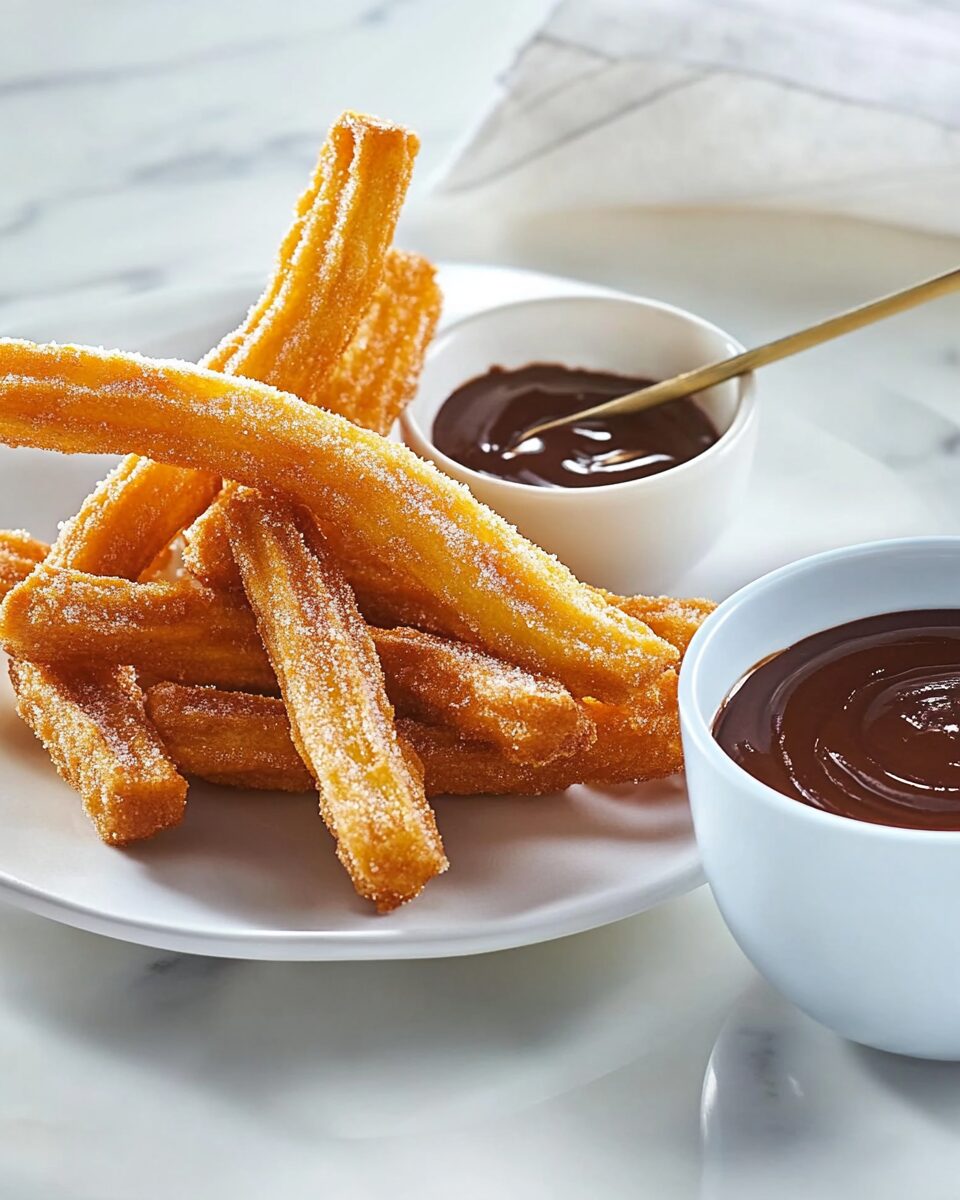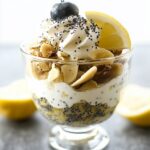Churros are a beloved Spanish dessert, featuring crispy fried dough coated in a sweet cinnamon-sugar mixture. Their golden exterior encases a tender, airy interior, making them an irresistible treat for any occasion. Traditionally enjoyed with a cup of thick hot chocolate for dipping, churros have become a favorite worldwide.
FULL RECIPE:
Ingredients:
- 1 cup water
- 2 ½ tablespoons white sugar
- ½ teaspoon salt
- 2 tablespoons vegetable oil
- 1 cup all-purpose flour
- 2 quarts oil for frying
- ½ cup white sugar, or to taste
- 1 teaspoon ground cinnamon
Directions:
- In a small saucepan over medium heat, combine water, 2 ½ tablespoons sugar, salt, and 2 tablespoons vegetable oil. Bring to a boil, then remove from heat.
- Stir in flour until the mixture forms a ball.
- Heat oil for frying in a deep fryer or deep pot to 375°F (190°C). Transfer dough to a sturdy pastry bag fitted with a medium star tip.
- Carefully pipe a few 5- to 6-inch strips of dough into the hot oil; work in batches to avoid crowding.
- Cook until golden; use a slotted spoon to transfer churros to paper towels to drain.
- Combine ½ cup sugar and cinnamon. Roll drained churros in the cinnamon-sugar mixture.
Nutrition Facts:
- Calories: 116 kcal
- Total Fat: 6g
- Saturated Fat: 1g
- Trans Fat: 0g
- Cholesterol: 0mg
- Sodium: 78mg
- Total Carbohydrates: 14g
- Dietary Fiber: 0.5g
- Sugars: 5g
- Protein: 1g
- Vitamin A: 0%
- Vitamin C: 0%
- Calcium: 1%
- Iron: 2%
The History of Churros
Churros are one of the most beloved pastries worldwide, originating from Spanish and Portuguese cuisine. The exact history of churros is still debated, but many believe they were introduced by Spanish shepherds who needed a simple, easy-to-make dough to fry over an open fire. The name “churro” is thought to be derived from the Churra sheep, a breed native to Spain whose horns resemble the shape of the pastry. Another theory suggests that Portuguese explorers brought a similar fried dough recipe from China called “Youtiao.” Over time, this dish evolved into the sweet, crispy churros we know today. When Spanish settlers arrived in Latin America, they brought churros with them, where they quickly became a staple street food. Today, churros are a popular treat in Spain, Mexico, Argentina, and many other countries, often enjoyed for breakfast or as a dessert.
Why Churros Are So Popular
The popularity of churros comes from their irresistible combination of crispy, golden-brown exteriors and soft, doughy centers. Their simplicity and versatility make them a favorite among all age groups. One of the reasons churros are so widely loved is their ability to pair well with a variety of dips, such as melted chocolate, dulce de leche, or even sweetened condensed milk. Street vendors worldwide sell churros as a grab-and-go snack, making them an accessible and affordable treat. Whether enjoyed plain, dusted in cinnamon sugar, or served with an indulgent dipping sauce, churros never fail to satisfy a sweet craving.
Variations of Churros Around the World
Though churros originated in Spain, different cultures have put their unique spin on this delightful pastry:
- Spanish Churros – Typically thinner and served with thick hot chocolate for dipping.
- Mexican Churros – Often filled with caramel, chocolate, or vanilla cream and rolled in cinnamon sugar.
- Argentinian Churros – Commonly stuffed with dulce de leche.
- French Churros (Chichi Frégis) – Found in the south of France, these churros are slightly sweeter and often enjoyed at fairs and festivals.
- Filipino Churros – Frequently served with a rich chocolate sauce similar to Spanish hot chocolate.
Best Ways to Enjoy Churros
One of the best things about churros is how they can be served in different ways:
- Dipped in Chocolate Sauce – The classic Spanish way of enjoying churros. Thick, warm chocolate sauce adds an indulgent richness to the crispy pastry.
- Stuffed Churros – Modern variations often include churros filled with caramel, Nutella, or vanilla cream.
- Churro Ice Cream Sandwiches – Two churros pressed together with ice cream in between for the ultimate dessert.
- Churro Bites – Small, bite-sized churros that are perfect for parties or easy snacking.
- Churro Sundaes – Crumbled churros sprinkled over ice cream, drizzled with caramel or chocolate sauce.
Tips for Making the Perfect Churros at Home
Making churros at home is easier than you might think, but achieving that perfect crispy texture requires a few essential tips:
- Use the Right Oil Temperature – The ideal frying temperature for churros is around 375°F (190°C). If the oil is too hot, the churros will brown too quickly and remain raw inside. If it’s too cold, they’ll absorb too much oil and become greasy.
- Pipe Evenly-Sized Churros – Using a star-tipped piping bag helps create the classic ridged texture, which helps the churros cook evenly.
- Don’t Overmix the Dough – Overworking the dough can result in tough churros instead of light and airy ones.
- Drain Excess Oil – Letting churros rest on a paper towel after frying helps remove excess oil and keeps them crispy.
- Roll in Cinnamon Sugar While Warm – Coating the churros while they’re still warm ensures that the cinnamon sugar sticks evenly.
Churros and Their Cultural Significance
Churros hold cultural significance in many countries and are enjoyed during special occasions and celebrations. In Spain, churros are a traditional breakfast food, often served with café con leche or thick hot chocolate. In Mexico, they are a common street food found in markets, fairs, and even sold outside churches on Sundays. In many parts of Latin America, churros are associated with festivals and holidays. During Christmas and New Year’s, they are a must-have treat. They are also a staple at carnivals and fairs in the United States and Europe.
Are Churros Vegan?
Traditional churros are made without eggs or dairy, making them naturally vegan. However, some variations may include butter or milk in the dough. If you’re making churros at home, you can ensure they are 100% plant-based by using simple ingredients like flour, water, sugar, and vegetable oil.
Churros vs. Doughnuts
Many people compare churros to doughnuts since both are fried pastries, but they have distinct differences:
- Churros have a firmer, crispier texture, whereas doughnuts are softer and fluffier.
- Churros are shaped into long strips or spirals, while doughnuts are round with a hole in the center.
- Churros are typically rolled in cinnamon sugar, while doughnuts can be glazed or frosted.
- Doughnuts often contain eggs and dairy, whereas churros are usually egg-free.
Conclusion
Churros are a delicious and versatile treat that has stood the test of time. Their crunchy, golden-brown exterior and soft, airy interior make them a favorite dessert or snack worldwide. Whether you enjoy them with a simple cinnamon-sugar coating, dipped in chocolate, or stuffed with creamy fillings, churros always hit the spot. Making churros at home allows you to experience their fresh, irresistible taste while experimenting with different flavors and fillings. Their long history and cultural significance make them more than just a sweet treat, they are a beloved part of culinary traditions across the globe.






